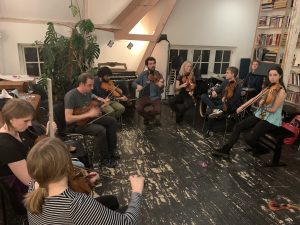The Dutch Viola Society has become a traditional presence and contributor at the bi-annual Amsterdam Viola Festival (AVF) and National Viola Competition. This year’s edition is no exception. Here’s a report from this year’s AVF, which took place this past week at the Conservatory of Amsterdam (CvA).
by Kristofer G. Skaug
Note 1: Expressions of personal opinion are entirely those of the author, and do not represent an official view of the Dutch Viola Society.
Note 2: For layout reasons, most pictures have been scaled down in size. Click on the images to view the full-size versions!
Note 3: This is a long blog post covering multiple days of festival activities. If you are particularly interested in a specific event, use the links below to skip forward:
Thursday, November 14th
Friday, November 15th
Saturday, November 16th: DVS National Viola Gathering
Sunday, November 17th: National Viola Competition Final
~~~~~~~~~~~~~~~~~~~~~~~~~~~~~~~~~~~~~~~~~~~~~~~~~~~~~~~~~~~~
Thursday, November 14th
 Usually, the DVS aspires to report from the National Viola Competition preliminary rounds, but due to limited resources, we could not consistently attend the 1st and 2nd rounds of this year’s competition. But we did put up our customary information table in the canteen, which this year included a plethora of fun viola merchandize (leftovers from last year’s IVC congress in Rotterdam).
Usually, the DVS aspires to report from the National Viola Competition preliminary rounds, but due to limited resources, we could not consistently attend the 1st and 2nd rounds of this year’s competition. But we did put up our customary information table in the canteen, which this year included a plethora of fun viola merchandize (leftovers from last year’s IVC congress in Rotterdam).
The Thursday evening concert featured CvA Faculty (Francien Schatborn, Marjolein Dispa, Richard Wolfe, Michel Dispa, Peter Brunt) in various ensembles. Among the many highlights, our local reporter was particularly enthusiastic about featured artist Garth Knox‘s performance of his own composition Cinq petites entropies for viola d’amore.
~~~~~~~~~~~~~~~~~~~~~~~~~~~~~~~~~~~~~~~~~~~~~~~~~~~~~~~~~~~~
Friday, November 15th
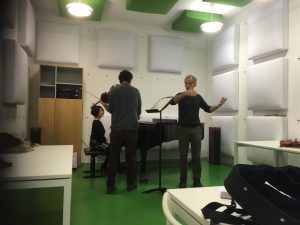 No competition activities today, but lots of masterclasses given by the CvA viola faculty and the festival guest artists, Veit Hertenstein and Garth Knox. One of our local DVS members caught a glimpse into the Garth Knox master class (photo on the left).
No competition activities today, but lots of masterclasses given by the CvA viola faculty and the festival guest artists, Veit Hertenstein and Garth Knox. One of our local DVS members caught a glimpse into the Garth Knox master class (photo on the left).
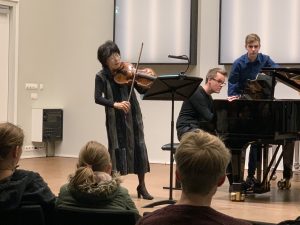 The evening concert brought a complete set of new viola transcriptions, such as Beethoven’s Horn sonata op.17 (played by Nobuko Imai and Martijn Willers) and Bartok’s Violin sonata no.2 (again Nobuko Imai, with Rie Tanaka on the piano). One cannot cease to admire Nobuko’s vitality and fantastic playing, it’s as if she has decided to never age. What a privilege for the Conservatory of Amsterdam to have her on the faculty (and for the DVS to have her as honorary member)!
The evening concert brought a complete set of new viola transcriptions, such as Beethoven’s Horn sonata op.17 (played by Nobuko Imai and Martijn Willers) and Bartok’s Violin sonata no.2 (again Nobuko Imai, with Rie Tanaka on the piano). One cannot cease to admire Nobuko’s vitality and fantastic playing, it’s as if she has decided to never age. What a privilege for the Conservatory of Amsterdam to have her on the faculty (and for the DVS to have her as honorary member)!
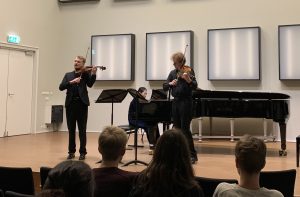 After the break, we heard featured artist Veit Hertenstein, first together with his student Martin Moriarty (a recent graduate of the CvA, and a runner-up in the 2017 National Viola Competition) in the viola-duo transcription of Five pieces for two violins and piano by Shostakovich. He went on to play a selection of Shostakovich’s violin Preludes op. 34 (on the viola of course). But his main title for this evening was a viola transcription of Schumann’s 2nd violin sonata (op.121). It’s quite a lengthy composition, but mr. Hertenstein played it very well. It’s a good thing to broaden the horizons of this obviously viola-centric crowd with some non-viola music, there are many more options out there in the classical repertoire waiting to be explored through viola transcriptions.
After the break, we heard featured artist Veit Hertenstein, first together with his student Martin Moriarty (a recent graduate of the CvA, and a runner-up in the 2017 National Viola Competition) in the viola-duo transcription of Five pieces for two violins and piano by Shostakovich. He went on to play a selection of Shostakovich’s violin Preludes op. 34 (on the viola of course). But his main title for this evening was a viola transcription of Schumann’s 2nd violin sonata (op.121). It’s quite a lengthy composition, but mr. Hertenstein played it very well. It’s a good thing to broaden the horizons of this obviously viola-centric crowd with some non-viola music, there are many more options out there in the classical repertoire waiting to be explored through viola transcriptions.
~~~~~~~~~~~~~~~~~~~~~~~~~~~~~~~~~~~~~~~~~~~~~~~~~~~~~~~~~~~~
Saturday, November 16th: DVS National Viola Gathering
Another competition-free day started out with more masterclasses at the Conservatory. We spent some time visiting the luthier tables in the Mezzanine upstairs. A good opportunity to test-drive some instruments and chat with the viola builders! It struck me that all conservatories should really organize yearly “meet an instrument builder” days for their string students to get properly informed about this hugely important supporting aspect of their future profession. To my knowledge, this is not systematically done today.
 But on to this day’s main course: The DVS National Viola Gathering! The performing arts “community house” Splendor Amsterdam is located only some 10 minutes’ walk from the Conservatory, with two beautiful chamber music recital halls and a very nice bar / lounge area. The DVS has already hosted several events here.
But on to this day’s main course: The DVS National Viola Gathering! The performing arts “community house” Splendor Amsterdam is located only some 10 minutes’ walk from the Conservatory, with two beautiful chamber music recital halls and a very nice bar / lounge area. The DVS has already hosted several events here.
 This afternoon’s viola gathering started out with a “scratch” viola ensemble/orchestra in the attic room of Splendor, getting together to play under the direction of DVS president Karin Dolman. Even yours truly had brought a viola, and settled in with the 4th viola group :-). We first played “A Modal March” by John Whittaker, the winning composition from last year’s 4Viola Composition Contest (sponsored by DVS and premiered at the IVC2018). It’s a very playable piece (even for amateurs)! Next, we played Peter Warlock’s Capriol Suite, arranged for violas-only by P. Taylor, one of the transcription musketeers of the famous AbsoluteZero Viola Quartet. This piece was considerably more challenging, due to the fast paces (renaissance dances) pimped with surprising 20th century harmonies. All in all, this ensemble session was good, clean viola fun 🙂
This afternoon’s viola gathering started out with a “scratch” viola ensemble/orchestra in the attic room of Splendor, getting together to play under the direction of DVS president Karin Dolman. Even yours truly had brought a viola, and settled in with the 4th viola group :-). We first played “A Modal March” by John Whittaker, the winning composition from last year’s 4Viola Composition Contest (sponsored by DVS and premiered at the IVC2018). It’s a very playable piece (even for amateurs)! Next, we played Peter Warlock’s Capriol Suite, arranged for violas-only by P. Taylor, one of the transcription musketeers of the famous AbsoluteZero Viola Quartet. This piece was considerably more challenging, due to the fast paces (renaissance dances) pimped with surprising 20th century harmonies. All in all, this ensemble session was good, clean viola fun 🙂
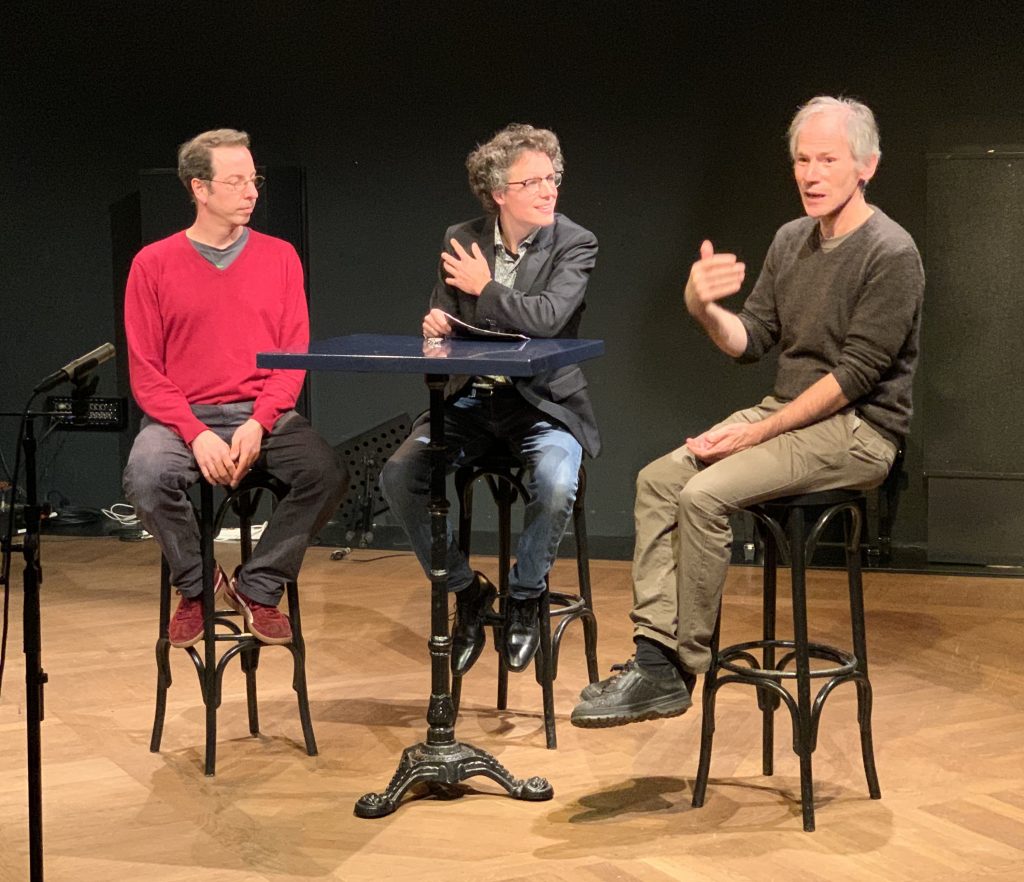 The ensuing “Talk Show” session convened a large audience in the main recital hall, where three violist-composers shared their experiences: Max Knigge (moderator), Garth Knox and Oene van Geel. The overarching topic was ‘composing for the viola’, but the conversation took many interesting detours, such as the relationship between composing and improvising (quote Garth Knox: “I often improvise when I see something in the score that I can’t figure out how to play“). There was plenty of interaction with questions from the audience, so the allotted hour flew by quickly!
The ensuing “Talk Show” session convened a large audience in the main recital hall, where three violist-composers shared their experiences: Max Knigge (moderator), Garth Knox and Oene van Geel. The overarching topic was ‘composing for the viola’, but the conversation took many interesting detours, such as the relationship between composing and improvising (quote Garth Knox: “I often improvise when I see something in the score that I can’t figure out how to play“). There was plenty of interaction with questions from the audience, so the allotted hour flew by quickly!
The viola crowd was next treated to a tasty meal, cooked and served by DVS (special thanks to Karin again!), a chicken cassarole with rice (including a vegetarian mushroom sauce option) and a raspberry/yoghurt dessert. It was good to have an hour off from blow-by-blow festival programming and still be together with lots of viola friends.
 So next, it was time for the traditional Viola Pitch: an opportunity for every violist to promote his or her pet topic, idea, project etc. I have to apologise at this point for hogging an inordinate amount of speaking time for plugging the DVS, but in the end there was also time for a couple of other speakers.
So next, it was time for the traditional Viola Pitch: an opportunity for every violist to promote his or her pet topic, idea, project etc. I have to apologise at this point for hogging an inordinate amount of speaking time for plugging the DVS, but in the end there was also time for a couple of other speakers.
Shortly after 20:00h, the densely programmed Evening concert started.
 A foursome of first-year students (Simon Rosier, Ana Castro, Ida Weidner and Elisa Misas Santos) treated us to a rare performance of Rita Hijman‘s viola quartet from 2006, originally dedicated to Esther Apituley. It is an interesting piece, and should be performed more often! The composer was herself present in the audience, and received an extra well-deserved round of applause. This was followed by a heartwarming rendition of Frank Bridge’s very popular (among violists) Lament for 2 violas, by Carlos Delgado and Sergio Montero del Pozo.
A foursome of first-year students (Simon Rosier, Ana Castro, Ida Weidner and Elisa Misas Santos) treated us to a rare performance of Rita Hijman‘s viola quartet from 2006, originally dedicated to Esther Apituley. It is an interesting piece, and should be performed more often! The composer was herself present in the audience, and received an extra well-deserved round of applause. This was followed by a heartwarming rendition of Frank Bridge’s very popular (among violists) Lament for 2 violas, by Carlos Delgado and Sergio Montero del Pozo.
The preliminary rounds of the National Viola Competition customarily prescribe specific solo works. In tonight’s concert, the jury’s favourite interpretations were encored. The programme included a movement (of choice) from Bach’s violin Sonatas and Partitas. Dagmar Korbar had selected the Andante from Sonata no. 2, a beautiful and meditative movement with a very characteristic continuo heartbeat on (mostly) open strings. Dagmar found a way of phrasing and stretching this pulse along with the melody, without sounding artificial or pretentious. Even though her rendition this evening wasn’t technically perfect, and even though I hadn’t heard any of her competitors’ Bach performances, it was clear to me that her interpretation fully deserved the jury’s acclaim.
Another mandatory piece (in the 2nd round) was the well-known Capriccio by Vieuxtemps (dedicated to Paganini). Seamus Hickey‘s interpretation was authentic and free, revealing fresh ways of navigating the many virtuosic turns.
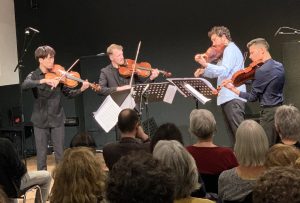 The 2017 National Viola Competition winner, Take Konoye, was given the privilege of performing York Bowen’s Phantasy Quartet with his very own dream team of viola friends: Martin Moriarty, Carlos Delgado and José Nunes. Next to the overall excellence of this performance, I particularly enjoyed Martin Moriarty’s contributions on the 2nd viola, with a lot of deeply vibrant personality.
The 2017 National Viola Competition winner, Take Konoye, was given the privilege of performing York Bowen’s Phantasy Quartet with his very own dream team of viola friends: Martin Moriarty, Carlos Delgado and José Nunes. Next to the overall excellence of this performance, I particularly enjoyed Martin Moriarty’s contributions on the 2nd viola, with a lot of deeply vibrant personality.
 And then, a true highlight of this evening: Garth Knox performing his own Pocket Concerto – thusly named thanks to the very “affordable” orchestra accompaniment of a single cello, played by Esther ten Kate. Garth and Esther gave us a fantastic performance, rich in textures and colours, with clear folk music inspirations. Afterward, I heard many spontaneous resolves from the violists in the audience to add this piece to their repertoire.
And then, a true highlight of this evening: Garth Knox performing his own Pocket Concerto – thusly named thanks to the very “affordable” orchestra accompaniment of a single cello, played by Esther ten Kate. Garth and Esther gave us a fantastic performance, rich in textures and colours, with clear folk music inspirations. Afterward, I heard many spontaneous resolves from the violists in the audience to add this piece to their repertoire.
After the break, the CvA Viola Class (and faculty) took the floor, playing a recap of their programme from the IVC in Rotterdam: First, the ensemble piece Cohort, violas only by Maurice Horsthuis. Conductor Max Knigge fused the 20+ violas into a well-tuned and finely synchronized organism, producing striking rhythmic patterns and colourful harmonics. He went on to lead the orchestra in his own composition Achille, Ajax & Moi (op.4, 2008), with Take Konoye as soloist. This piece comes in nine short episodes with varying characters. From the rear of the tutti 1st viola section, Duleen van Gunsteren supplied imaginative special effects, blowing and humming into his viola, and producing eerie scratching and squeaking sounds using extended bowing techniques (no viola joke, this time).
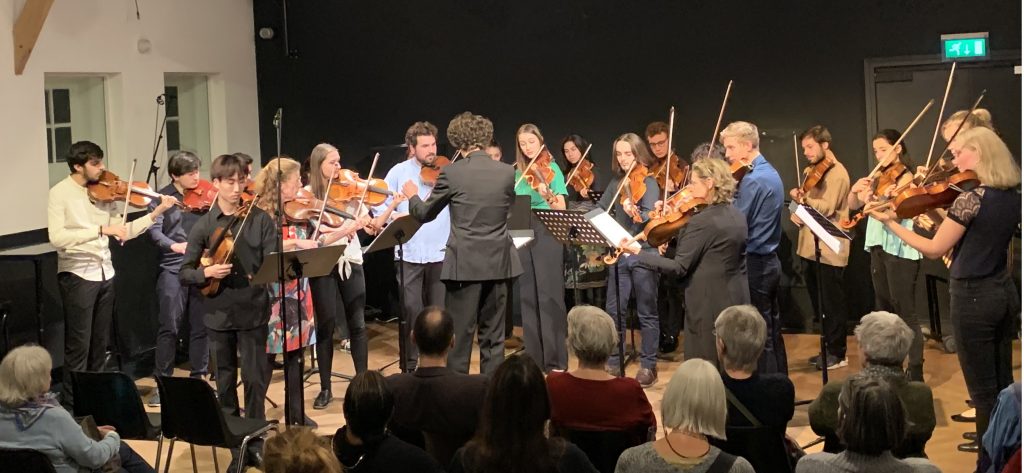 As an encore, the orchestra played (their own 1st-year member) Ida Weidner‘s transcription of the Beatles’ Eleanor Rigby, a highly appreciated and fitting close of this concert.
As an encore, the orchestra played (their own 1st-year member) Ida Weidner‘s transcription of the Beatles’ Eleanor Rigby, a highly appreciated and fitting close of this concert.
But it wasn’t over yet! No proper festival can do without a bit of informal late-night music making. Up in the attic, the party continued into the wee hours. The Sister Act of Ursula and Sunniva Skaug kicked things off with Message Ground by Robert Davidson, a canon for 2 violas and tape, based on Message in a Bottle by The Police.
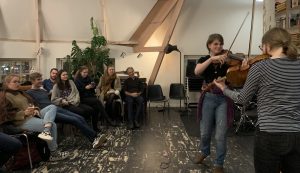
 José Nunes played the beautiful miniature Le Soir by Vierne, and Duleen van Gunsteren threw in some solo pieces. Lillian Haug surprised and delighted us by combining virtuosic drumming and viola playing in a one-(wo)man jazz set, and the 1st-year quartet (which played Hijmans earlier this evening) played another Beatles arrangement. And then … Oene van Geel swept up the whole crowd for an extended jam session with drums, piano, treble violin (cool!) and at least 10 violas. We left Splendor at 1 o’clock in the morning, thoroughly and suitably drenched in viola, viola, and viola everything!
José Nunes played the beautiful miniature Le Soir by Vierne, and Duleen van Gunsteren threw in some solo pieces. Lillian Haug surprised and delighted us by combining virtuosic drumming and viola playing in a one-(wo)man jazz set, and the 1st-year quartet (which played Hijmans earlier this evening) played another Beatles arrangement. And then … Oene van Geel swept up the whole crowd for an extended jam session with drums, piano, treble violin (cool!) and at least 10 violas. We left Splendor at 1 o’clock in the morning, thoroughly and suitably drenched in viola, viola, and viola everything!
~~~~~~~~~~~~~~~~~~~~~~~~~~~~~~~~~~~~~~~~~~~~~~~~~~~~~~~~~~~~
Sunday, November 17th: Final of the National Viola Competition
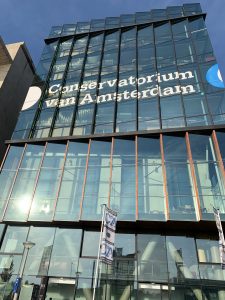 The final (and in this case, beautifully sunny) day of the 2019 Amsterdam Viola Festival is all about the Final round of the National Viola Competition. Remarkably, the three finalists are all undergraduate 2nd- and 1st-year students (in previous years, quite naturally, a majority of the finalists were at least Master students or even post-graduate). There are no native Dutch among the finalists, but two Irishmen and a Croatian. Maybe we should rename the competition “Dutch Open” :-).
The final (and in this case, beautifully sunny) day of the 2019 Amsterdam Viola Festival is all about the Final round of the National Viola Competition. Remarkably, the three finalists are all undergraduate 2nd- and 1st-year students (in previous years, quite naturally, a majority of the finalists were at least Master students or even post-graduate). There are no native Dutch among the finalists, but two Irishmen and a Croatian. Maybe we should rename the competition “Dutch Open” :-).
This year marked the first time that the competition finalists had a full orchestra at their disposal: the CvA Symphony Orchestra (dubbed Philharmonic Fridays), led by Ed Spanjaard. The mandatory piece in this round was the “Brahms viola concerto“, actually a transcription of Brahms’ clarinet/viola sonata op.120 no.1 by Luciano Berio.
 The first finalist is Seamus Hickey. We heard him yesterday in his very free and evocative Vieuxtemps Capriccio, and he needs and takes these freedoms also in Brahms. Unfortunately, this “chamber musical” approach sometimes proves difficult for a big orchestra to follow. Which begs the following question: When a sonata is re-cast as a concerto, should it still be regarded and played like chamber music? His interpretation is lively and heartfelt, and his face shows clear signs of the enormous mental and emotional energy that he invests in his performance. But his sound sometimes lacks volume, and his attempts to compensate results in some texture cracks.
The first finalist is Seamus Hickey. We heard him yesterday in his very free and evocative Vieuxtemps Capriccio, and he needs and takes these freedoms also in Brahms. Unfortunately, this “chamber musical” approach sometimes proves difficult for a big orchestra to follow. Which begs the following question: When a sonata is re-cast as a concerto, should it still be regarded and played like chamber music? His interpretation is lively and heartfelt, and his face shows clear signs of the enormous mental and emotional energy that he invests in his performance. But his sound sometimes lacks volume, and his attempts to compensate results in some texture cracks.
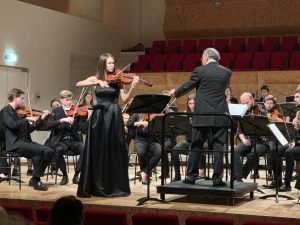 How different is Dagmar Korbar’s appearance! She stands poised and calm in her black dress, almost aloof in her facial expression, unperturbed by the high stakes of the situation. Her tone is polished, clear and powerful, and her technique is impeccable. The performance is very convincing. I do wonder if her remarkable self-control also hides a wilder, less risk-averse musical creature? I’d hope to hear that some day, circumstances allowing … (this is a question that often occurs to me when I attend competitions – which again feeds the suspicion that, in their essence, music and competitions are rather mismatched concepts).
How different is Dagmar Korbar’s appearance! She stands poised and calm in her black dress, almost aloof in her facial expression, unperturbed by the high stakes of the situation. Her tone is polished, clear and powerful, and her technique is impeccable. The performance is very convincing. I do wonder if her remarkable self-control also hides a wilder, less risk-averse musical creature? I’d hope to hear that some day, circumstances allowing … (this is a question that often occurs to me when I attend competitions – which again feeds the suspicion that, in their essence, music and competitions are rather mismatched concepts).
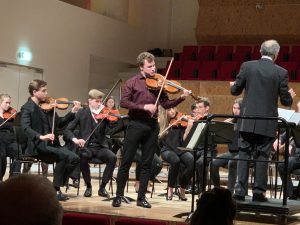 The last finalist is Fiachra de Hora, the only first-year student, and the only one to play the Brahms entirely by heart. He also had the good sense of tuning all strings on stage, rather than relying on a backstage pre-tune (that open C-string betrayed the two others at a few points). While we’re handing out bonus points for non-musical matters, here’s +1 for wearing a purple (viola!) coloured shirt!
The last finalist is Fiachra de Hora, the only first-year student, and the only one to play the Brahms entirely by heart. He also had the good sense of tuning all strings on stage, rather than relying on a backstage pre-tune (that open C-string betrayed the two others at a few points). While we’re handing out bonus points for non-musical matters, here’s +1 for wearing a purple (viola!) coloured shirt!
Fiachra exhibits a highly matured technique and musicality. His control is remarkable, and he even seems to apply his spare brainwaves for will-powering the orchestra when they threaten to divert from his wishes in tempo or dynamics. With such skills, after a while I forget he is a 1st-year student, and try to summon a more critical observation. Maybe it’s that neck and left shoulder – a bit rigid. And there were perhaps some passages that the competitors managed with more elegance or a more convincing sound output. But in my book, those were the exceptions. In my mind, here’s the next Timothy Ridout! My audience prize vote goes to him, and it eventually turns out that the rest of the audience in majority agreed with me.
The jury, consisting of Ronald Kieft (chair), Jürgen Kussmaul, Veit Hertenstein, Garth Knox and Anna-Magdalena den Herder (the 2011 winner), did not need long to decide on the overall competition results: Dagmar Korbar is our new “National Champ”, with Seamus and Fiachra (in that order) as runners-up. It was clear that the achievements of the preliminary rounds were factoring into this decision, and remembering Dagmar’s Bach from last night, it seems very plausible that she was the best all-round player, even if Fiachra deservedly won today’s audience prize.
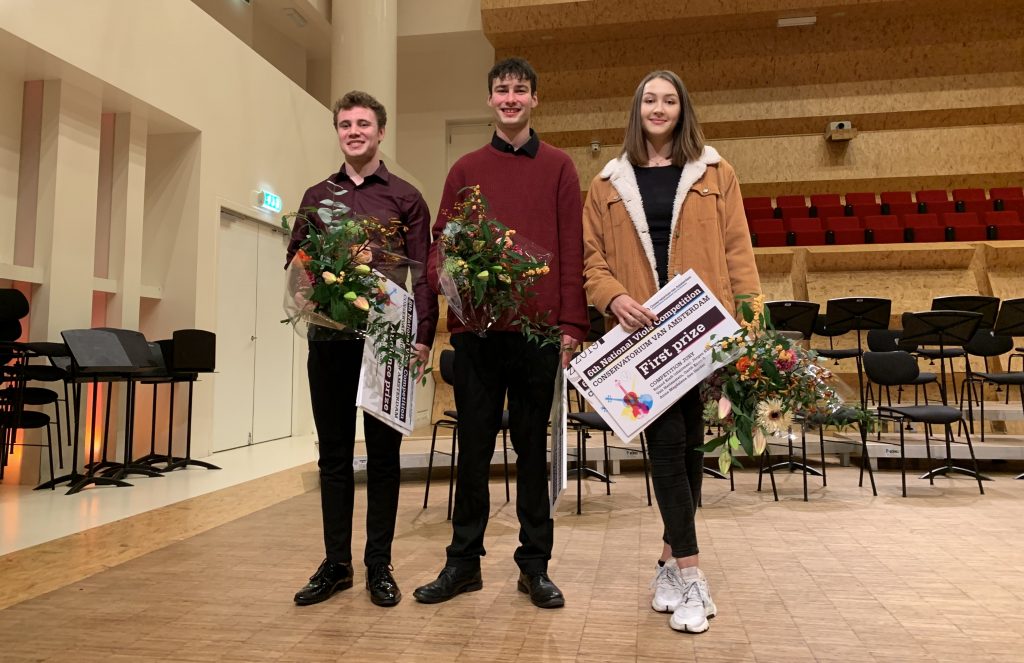 Congratulations to all three finalists for their superb performances, and to the Conservatory for attracting and developing such outstanding talents. And endless thanks to Francien Schatborn and Marolein Dispa for organizing once again the Amsterdam Viola Festival. We all hope to be able to return in 2021 for the next exciting edition!
Congratulations to all three finalists for their superb performances, and to the Conservatory for attracting and developing such outstanding talents. And endless thanks to Francien Schatborn and Marolein Dispa for organizing once again the Amsterdam Viola Festival. We all hope to be able to return in 2021 for the next exciting edition!

